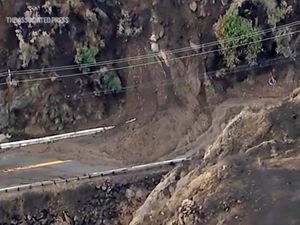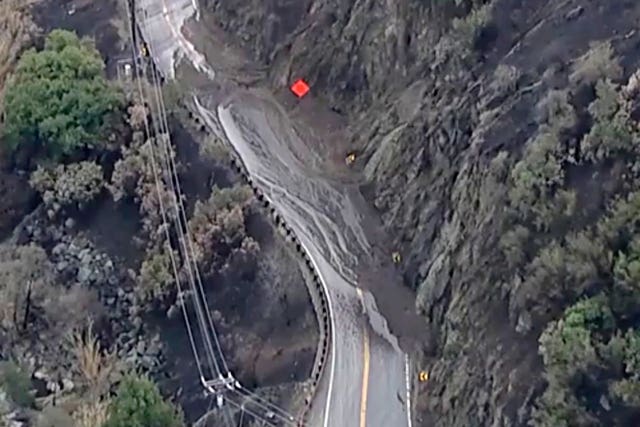Rain in Southern California creates mudflows – but helps firefighters
Flood watches are in effect for areas hit by the recent wildfires in Los Angeles.

More rain has fallen on parts of Southern California after causing mudflows over the weekend – helping firefighters, but boosting the risk of toxic ash run-off in areas scorched by Los Angeles-area wildfires.
Flood watches are in effect for burn areas from recent fires that broke out around the Pacific Palisades area in Los Angeles, Altadena and Castaic Lake, said Joe Sirard, a meteorologist for the US National Weather Service in Oxnard.
“All these fresh burns are very susceptible to rapid run-off,” Mr Sirard said, warning of even small amounts of rain in a few minutes’ time.
“What that means is we have a fairly high danger of mud and debris flows once we get above those thresholds.”
Los Angeles International Airport reported a little under an inch of rain in a 24-hour period ending at 3am local time on Monday, the National Oceanic and Atmospheric Administration reported.
Surrounding areas reported lesser amounts.
Four schools in the Santa Monica-Malibu Unified School District were closed on Monday “due to dangerous road conditions and challenges with access to our schools”, school officials posted online.
A portion of the Pacific Coast Highway in Los Angeles County was closed as of Sunday afternoon due to mudflows in Topanga Canyon, the California Department of Transportation said. Snow fell in the mountains.
One benefit that could come from the rain is that it may help firefighters who are reining in multiple wildfires after weeks of windy and dry weather.
Los Angeles County crews spent much of last week removing vegetation, shoring up slopes and reinforcing roads in devastated areas of the Palisades and Eaton fires, which reduced entire neighbourhoods to rubble and ash after breaking out during powerful winds on January 7.
The Palisades Fire, the largest of the blazes that destroyed thousands of homes and killed at least 11 people, reached 90% containment on Sunday. The Eaton Fire, which broke out near Altadena and has killed at least 16 people, was 98% contained.

The Hughes Fire, which ignited last week north of Los Angeles and caused evacuation orders or warnings for more than 50,000 people, was 95% contained as of Sunday evening.
In San Diego County, firefighters made progress to contain the smaller Border 2 Fire as it burned through a remote area of the Otay Mountain Wilderness near the US-Mexico border.
Most of the region was forecast to get about an inch of precipitation over several days, but the weather service warned of a risk of localised cloudbursts causing mud and debris to flow down hills.
“So the problem would be if one of those showers happens to park itself over a burn area,” weather service meteorologist Carol Smith said on social media. “That could be enough to create debris flows.”
Los Angeles Mayor Karen Bass issued an executive order last week to expedite clean-up efforts and mitigate the environmental impacts of fire-related pollutants.
LA County supervisors also approved an emergency motion to install flood-control infrastructure and expedite and remove sediment in fire-impacted areas.
Fire crews filled sandbags for communities, while county workers installed barriers and cleared drainage pipes and basins.
Officials cautioned that ash in recent burn zones was a toxic mix of incinerated cars, electronics, batteries, building materials, paints, furniture and other household items.
It contains pesticides, asbestos, plastics and lead. Residents were urged to wear protective gear while cleaning up.
Concerns about post-fire debris flows have been especially high since 2018, when the town of Montecito, up the coast from Los Angeles, was ravaged by mudslides after a downpour hit mountain slopes burned bare by a huge blaze. Hundreds of homes were damaged and 23 people died.
The rain snapped a near-record streak of dry weather for Southern California. Most of Southern California is currently in “extreme drought” or “severe drought”, according to the US Drought Monitor.





